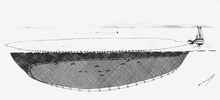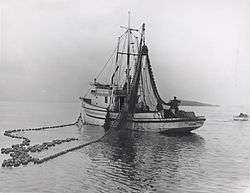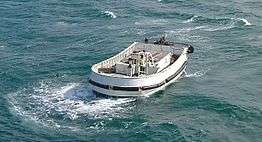Seine fishing

.png)
Seine (/seɪn/ SAYN) fishing (or seine-haul fishing) is a method of fishing that employs a seine or dragnet. A seine is a fishing net that hangs vertically in the water with its bottom edge held down by weights and its top edge buoyed by floats. Seine nets can be deployed from the shore as a beach seine, or from a boat.
Boats deploying seine nets are known as seiners. There are two main types of seine net deployed from seiners: purse seines and Danish seines.
History
Seines have been used widely in the past, including by stone age societies. For example, with the help of large canoes, pre-European Māori deployed seine nets which could be over one thousand metres long. The nets were woven from green flax, with stone weights and light wood or gourd floats, and could require hundreds of men to haul.[1]
American Native Indians on the Columbia River wove seine nets from spruce root fibers or wild grass, again using stones as weights. For floats they used sticks made of cedar which moved in a way which frightened the fish and helped keep them together.[2]
Seine nets are also well documented in ancient cultures in the Mediterranean region. They appear in Egyptian tomb paintings from 3000 BC. In ancient Greek literature, Ovid makes many references to seine nets, including the use of cork floats and lead weights.[3][4][5]
Purse seine


A common type of seine is a purse seine, named such because along the bottom are a number of rings. A line (referred to as a purse-line) passes through all the rings, and when pulled, draws the rings close to one another, preventing the fish from "sounding", or swimming down to escape the net. This operation is similar to a traditional style purse, which has a drawstring. The purse seine is a preferred technique for capturing fish species which school, or aggregate, close to the surface: such as sardines, mackerel, anchovies, herring, certain species of tuna (schooling); and salmon soon before they swim up rivers and streams to spawn (aggregation). Boats equipped with purse seines are called purse seiners.
Purse seine fishing can be a relatively sustainable way of fishing, as it can result in smaller amounts of by-catch (unintentionally caught fish), especially when used to catch large species of fish (like herring or mackerel) that shoal tightly together.[6] When used to catch fish that shoal together with other species, or when used in parallel with Fish aggregating devices, the percentage of by-catch greatly increases.[6]
Use of Purse seines are regulated by many countries. In Sri Lanka, using this type of nets within a radius of 7 kilometers offshore is illegal.[7] However it can be used in deep sea after obtaining permission from authorities. Purse seine fishing can have negative impacts on fish stocks because it can involve the bycatch of non-target species and it can put too much pressure on fish stocks.[8]


Power block


The power block is a mechanized pulley used on some seiners to haul in the nets. According to the UN Food and Agriculture Organization, no single invention has contributed more to the success of purse seine net hauling than the power block.[9]
The Puretic power block line was introduced in the 1950s and was the key factor in the mechanization of purse seining. The combination of these blocks with advances in fluid hydraulics and the new large synthetic nets changed the character of purse seine fishing. The original Puretic power block was driven by an endless rope from the warping head of a winch. Nowadays, power blocks are usually driven by hydraulic pumps powered by the main or auxiliary engine. Their rpm, pull and direction can be controlled remotely.[9]
A minimum of three people are required for power block seining; the skipper, skiff operator, and corkline stacker. In many operations a fourth person stacks the leadline, and often a fifth person stacks the web.
Drum

In Canada, specifically on the coast of British Columbia drum seining is a method of seine fishing which was adopted in the late 1950s and is now used exclusively in that region.[10]
The drum seine uses a horizontally mounted drum to haul and store the net instead of a power block. The net is pulled in over a roller, which spans the stern, and then passes through a spooling gear with upright rollers. The spooling gear is moved from side to side across the stern which allows the net to be guided and wound tightly on the drum.[11]
There are several advantages to the drum seine over the power block. The net can be hauled very quickly, more than twice the speed of using a power block, the net does not require overhead handling and the process is therefore safer. The most important advantage is that the drum system can be operated with fewer deckhands.
Danish seine
A Danish seine, also occasionally called an anchor seine, consists of a conical net with two long wings with a bag where the fish collect. Drag lines extend from the wings, and are long so they can surround an area.
A Danish seine is similar to a small trawl net, but the wire warps are much longer and there are no otter boards. The seine boat drags the warps and the net in a circle around the fish. The motion of the warps herds the fish into the central net.
Danish seiner vessels are usually larger than purse seiners, though they are often accompanied by a smaller vessel. The drag lines are often stored on drums or coiled onto the deck by a coiling machine. A brightly coloured buoy, anchored as a "marker", serves as a fixed point when hauling the seine. A power block, usually mounted on a boom or a slewing deck crane, hauls the seine net.
Danish seining works best on demersal fish which are either scattered on or close to the bottom of the sea, or are aggregated (schooling). They are used when there are flat but rough seabeds which are not trawlable. It is especially useful in northern regions, but not much in tropical to sub-tropical areas.
The net is deployed, with one end attached to an anchored dan (marker) buoy, by the main vessel, the seiner, or by a smaller auxiliary boat. A drag line is paid out, followed by a net wing. As the seiner sweeps in a big circle returning to the buoy, the deployment continues with the seine bag and the remaining wing, finishing with the remaining drag line. In this way a large area can be surrounded. Next the drag lines are hauled in using rope-coiling machines until the catch bag can be secured.
The seine netting method developed in Denmark. Scottish seining ("fly dragging") was a later modification. The original procedure is much the same as fly dragging except for the use of an anchored marker buoy when hauling, and closing the net and warps and net by winch.
Other images
|
Purse seining     Seining in the past    |
See also
|
| |
|
|
Notes
- ↑ Meredith, Paul "Te hī ika – Māori fishing" Te Ara - the Encyclopedia of New Zealand. Updated 2 March 2009.
- ↑ Smith, Courtland L Seine fishing Oregon Encyclopedia. Retrieved 23 March 2012.
- ↑ Radcliffe W (1926) Fishing from the Earliest Times John Murray, London.
- ↑ Johnson WM and Lavigne DM (1999) Monk Seals in Antiquity Fisheries, pp. 48–54. Netherlands Commission for International Nature Protection.
- ↑ Gilroy, Clinton G (1845) "The history of silk, cotton, linen, wool, and other fibrous substances: including observations on spinning, dyeing and weaving" pp. 455–464. Harper & Brothers, Harvard University.
- 1 2 Purse-seining: when fishing methods go bad, Greenpeace, 18 May 2010
- ↑ "Sri Lanka fisheries authorities and navy to act against local fishermen using illegal fishing methods". Colombopage. 21 Oct 2013.
- ↑ http://www.greenpeace.org.uk/blog/oceans/purse-seining-when-fishing-methods-go-bad-20100518
- 1 2 FAO Fishing Equipment: Power block
- ↑ A Paean to Purse Seiners and Seafood Fest Seattle Press Online, 15 July 1999.
- ↑ FAO: Fishing Techniques: Drum seining Rome. Retrieved 22 December 2009.
References
- Division of Commercial Fisheries (2005-07-26). "Commercial Purse Seine Fishery". Alaska Department of Fish and Game. Retrieved 2008-04-20.
- Gabriel O., von Brandt A., Lange K., Dahm E. and Wendt T. (2005) Fish catching methods of the world: Seining in fresh and sea water Wiley-Blackwell, Page 431–448. ISBN 978-0-85238-280-6
- Seine nets Fishing Gear Types. FAO, Rome. Retrieved 13 March 2012.
- Beach seines Fishing Gear Types. FAO, Rome. Retrieved 13 March 2012.
- Boat seines Fishing Gear Types. FAO, Rome. Retrieved 13 March 2012.
- Two boat purse seining Fishing Techniques. FAO, Rome. Retrieved 13 March 2012.
- Purse seines Fishing Gear Types. FAO, Rome. Retrieved 13 March 2012.
External links
| Look up seine in Wiktionary, the free dictionary. |
| Wikimedia Commons has media related to Seiners. |
- WorldFishingToday - Fishing vessels photos and data
- Video: Purse Seine Fishing
- Video: Purse Seine Delivery - Prince William Sound, Alaska
- Video: Purse Seiner at Work
- Video: Traditional purse seining in the Bali Strait, Indonesia
- Safety Video: The Most Powerful Thing...Deck Safety Awareness for Purse Seiners
- Seine Netting
- Purse Seining Seafood Watch, Fishing Methods Fact Card. Retrieved 23 January 2012.
| |||||||||||||||||||||||||||||||||||||||||||||||||||||||||||||||||||||||||||||||||||
| |||||||||||||||||||||||||||||||||||||

